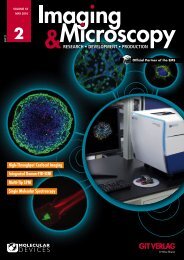SIM0216
Create successful ePaper yourself
Turn your PDF publications into a flip-book with our unique Google optimized e-Paper software.
LIGHT MICROSCOPY<br />
For observation a microscope objective<br />
lens with an appropriate working<br />
distance should be chosen to reach<br />
at least the level of the rotation axis of<br />
the sample. Good results can be achieved<br />
by objective lenses with low numerical<br />
apertures, e.g. 5x/0.15, 10x/0.30 or<br />
20x/0.50 lenses. Alternatively, for higher<br />
magnification a 63x/0.9 water dipping<br />
objective lens turned out to be suitable.<br />
Exemplary Results<br />
Figures 2 and 3 show some exemplary<br />
results. The images depicted are z-projections<br />
from eight different rotation<br />
angles. The copepod in figure 2 was incubated<br />
with rhodamine 6G at a concentration<br />
of 10 µM for 24 h. Fluorescence<br />
images were recorded by confocal<br />
laser scanning microscopy using an excitation<br />
wavelength of 488 nm. Fluorescence<br />
was detected using a long pass filter<br />
with cut-off wavelength at 505 nm.<br />
Image stacks from each direction consist<br />
of 100 images recorded at distances<br />
of ∆z = 6 µm.<br />
Figure 3 shows z-projection images of<br />
a zebrafish embryo recorded by confocal<br />
laser scanning microscopy at the Institute<br />
of Molecular Biology (IMB), Mainz,<br />
Germany.<br />
References<br />
All references are available online:<br />
http://bit.ly/IM-Bruns<br />
Affiliation<br />
1<br />
Aalen University, Institute of Applied<br />
Research, Aalen, Germany<br />
Contact<br />
Dr. Thomas Bruns<br />
Aalen University<br />
Institute of Applied Research<br />
Aalen, Germany<br />
thomas.bruns@hs-aalen.de<br />
www.hs-aalen.de<br />
Fig. 2: Fluorescence z-projection images of 8<br />
individual rotation steps of a copepod with<br />
half-filled egg sac incubated with rhodamine 6G<br />
(10 µM, 24 h) recorded by confocal laser scanning<br />
microscopy (excitation wavelength: 488 nm;<br />
fluorescence detected at λ ≥ 505 nm; each<br />
z-stack: Δz = 6 µm, 100 images).<br />
Fig. 3: Fluorescence z-projection images of 8<br />
individual rotation steps of a zebrafish embryo<br />
recorded by confocal laser scanning microscopy<br />
[Images recorded by Holger Dill, Mária Hanulová,<br />
and Sandra Ritz, Institute of Molecular<br />
Biology (IMB), Mainz, Germany].<br />
Read more about 3D Imaging:<br />
http://bit.ly/IM-3D<br />
Recent information on<br />
Confocal Laser Scanning Microscopy:<br />
http://bit.ly/IM-CLS<br />
[1]<br />
All references:<br />
http://bit.ly/IM-Bruns<br />
Visit us at Optatec, Frankfurt · Booth C29<br />
OPTICAL FILTERS<br />
For Fluorescence Spectroscopy<br />
AHF analysentechnik AG · +49 (0)7071 970 901-0 · info@ahf.de<br />
www.ahf.de<br />
30 • G.I.T. Imaging & Microscopy 2/2016



